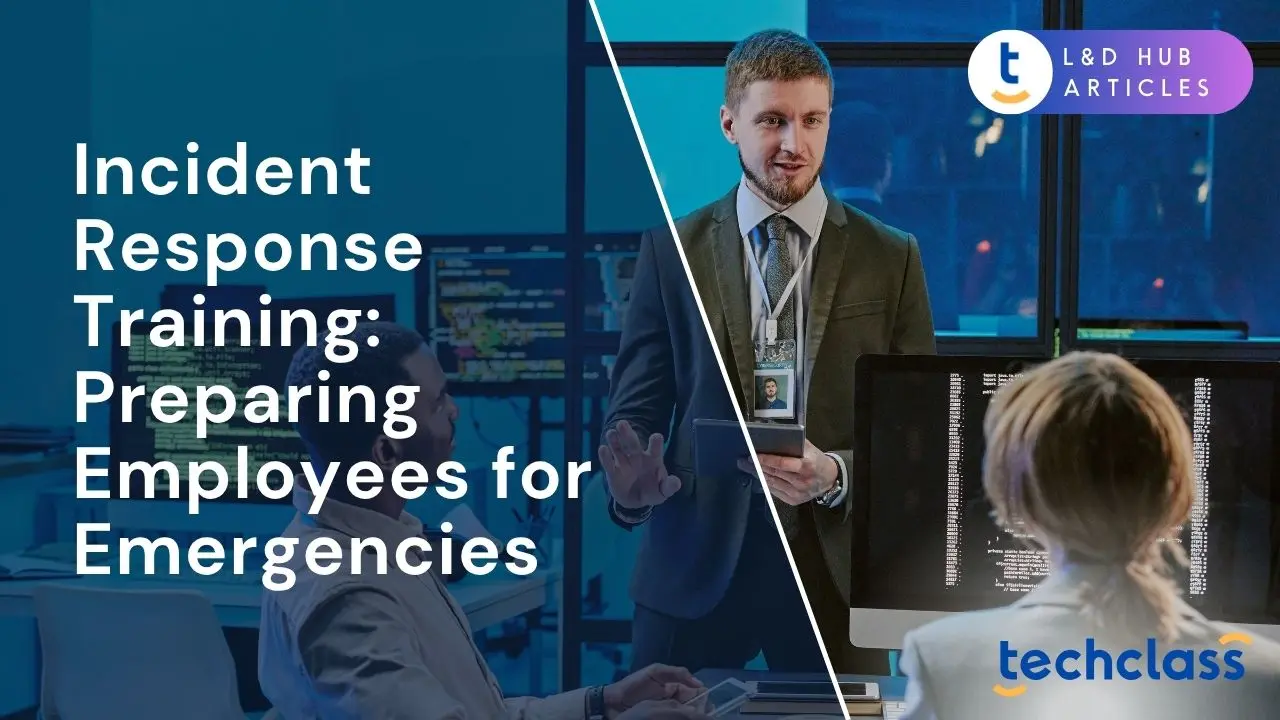
Emergencies can strike any workplace without warning – from natural disasters and power outages to cyber-attacks or medical crises. How a company responds in the first critical moments can mean the difference between a minor disruption and a catastrophic loss. An incident that spirals out of control can endanger employees, damage assets, and even threaten the very survival of a business. In fact, studies have found that a large percentage of businesses never reopen after a major disaster, underscoring how high the stakes can be. This is why incident response training for employees is not a luxury or mere formality; it is a vital investment in safety and business resilience. By preparing staff to react swiftly and effectively when the unexpected happens, organizations can save lives, protect their operations, and mitigate damage. In the following sections, we will explore what incident response training entails, why it’s so important across all industries, and the key benefits it brings to organizations.
Incident response training is a structured program that prepares employees to handle unexpected emergencies in the workplace. It involves educating staff about potential incidents – such as fires, industrial accidents, natural disasters, cybersecurity breaches, or medical emergencies – and teaching them the specific actions to take when these events occur. This training typically covers procedures like emergency evacuation routes, use of safety equipment (e.g. fire extinguishers or first-aid kits), communication protocols during a crisis, and roles and responsibilities for response team members. The goal is to ensure that everyone from front-line employees to managers knows how to react quickly and correctly under pressure. Incident response training is not limited to any one industry or type of emergency; it’s as relevant for an office preparing for an active shooter scenario or data breach as it is for a factory preparing for equipment malfunctions or chemical spills. By practicing drills and scenario-based exercises, employees build muscle memory and confidence so that when a real incident happens, they can respond in a calm, organized manner rather than panic. In essence, incident response training turns chaotic, high-stress situations into manageable scenarios by giving your workforce the knowledge and skills to tackle emergencies head-on.
Protecting human life and well-being is the foremost priority during any crisis. Incident response training directly supports this priority by equipping employees with the know-how to stay safe and help others in dangerous situations. For example, trained employees will know how to evacuate a building quickly during a fire or earthquake, where to find exits and muster points, and how to assist colleagues or customers who may need help. They learn to remain calm and follow established emergency procedures rather than giving in to fear. This can dramatically reduce the risk of injuries or fatalities when every second counts. Consider a medical emergency in the workplace: if staff have been trained in basic first aid and emergency response, someone suffering a cardiac arrest or severe injury can receive critical initial care (like CPR or bleeding control) while waiting for professional responders, potentially saving that person’s life. Beyond the physical safeguards, having all employees trained also reduces panic and confusion. Each person understands their role – whether it’s shutting down equipment, calling 911, or guiding others to safety – which means fewer people milling about unsure of what to do. In high-stress events, confidence and clarity can prevent chaos, and that comes from preparation. Ultimately, incident response training demonstrates a company’s commitment to its people’s safety. Employees who feel that their employer has empowered them with life-saving knowledge are more likely to trust the organization and look out for one another. Especially for HR professionals and leaders, ensuring your workforce can protect themselves and their peers in an emergency isn’t just about compliance – it’s an ethical responsibility and a cornerstone of duty of care.
While employee safety comes first, organizations also need to safeguard their property, systems, and operational capability during a crisis. Effective incident response training helps minimize physical damage and downtime by enabling a swift, coordinated reaction that can contain an incident before it escalates. For instance, if a small electrical fire breaks out in a facility, workers who have practiced the emergency protocol will know how to trigger the alarm, use a fire extinguisher correctly to put out the flames, and shut down nearby machinery if necessary. Such quick actions can prevent a minor flame from turning into a devastating blaze that destroys equipment or buildings. Similarly, in a cybersecurity incident like a malware outbreak, employees who are trained to recognize warning signs can report the issue immediately and follow the IT team’s instructions (such as isolating their computer from the network), helping to contain the breach and protect digital assets. This prompt containment significantly reduces the impact on critical operations.
From a business continuity perspective, incident response training prepares staff to keep essential functions running or to restore them faster after disruption. Downtime is extremely costly – every hour (or even minute) of halted production, service outage, or IT system shutdown can mean lost revenue and unhappy customers. Trained teams can execute contingency plans smoothly: for example, switching to backup systems, relocating to a safe alternate site, or performing manual operations if automated systems fail. By promptly managing and demobilizing incidents, companies reduce downtime and financial losses. There are real financial incentives for this readiness. Research in the cybersecurity realm has shown that organizations with well-prepared incident response teams and plans save significant money when incidents occur. One analysis found that companies with a robust incident response plan (that is regularly tested) reduced the average cost of a data breach by over 60%, saving millions of dollars compared to those unprepared. Across all types of emergencies, the principle holds true: the faster you can halt the damage and resume normal operations, the less long-term cost and disruption your business will suffer. In short, investing in training today can avert devastating losses tomorrow by protecting your facilities, technology, and capabilities from harm.
Another crucial benefit of incident response training is ensuring your organization meets legal and regulatory requirements for emergency preparedness. Many jurisdictions and industries mandate that businesses have emergency action plans and conduct regular employee training on those plans. For example, the U.S. Occupational Safety and Health Administration (OSHA) requires most workplaces to maintain an Emergency Action Plan and to train employees on evacuation procedures, fire response, and other emergency steps specific to their site. Failing to comply with such regulations can result in hefty fines, sanctions, or even closure orders. By systematically training your staff and documenting those training activities, you can avoid regulatory non-compliance penalties and demonstrate to inspectors that safety is taken seriously. Beyond government rules, certain industries have standards (like NFPA guidelines for fire safety or ISO standards for information security incident management) that customers or partners expect you to follow. Proper training helps satisfy these standards and maintain certifications or insurance coverages that require emergency readiness.
In addition to compliance, incident response training reduces the overall liability and legal risks associated with emergencies. If an accident or disaster occurs and employees are hurt or stakeholders incur losses, companies that neglected to prepare may face lawsuits for negligence. Conversely, demonstrating that employees were well-trained and that the company had done everything reasonably possible to prevent and respond to the incident can mitigate legal liability. For instance, consider two scenarios: one company has no clear emergency procedure and an employee injury turns into a legal claim citing lack of training, whereas another company can show that the injured employee had been through regular safety drills and training – the latter will fare much better in court or settlement negotiations. Training also teaches employees how to properly report and escalate incidents, which ensures that issues are logged and handled by the book. Accurate reporting and quick notification to authorities (when needed) can keep your organization on the right side of laws that require disclosure of certain incidents (such as environmental spills or data breaches). Furthermore, insurers often look favorably on companies with proactive risk management practices. Some insurance providers may even lower premiums or provide benefits for companies that conduct regular emergency response training, since a trained workforce means fewer and less severe claims. In summary, prioritizing incident response training helps your business stay compliant with safety laws and reduces the risk of costly legal consequences if something goes wrong.
How an organization handles a crisis can dramatically shape public perception and stakeholder trust. A poorly managed emergency – one that causes preventable harm or unfolds chaotically in the public eye – can tarnish a company’s reputation for years. Customers, clients, and partners want to feel confident that the businesses they deal with are reliable and prepared, even under duress. Incident response training plays a direct role in preserving your reputation by enabling a professional, effective crisis response. When employees are trained on not only the technical response to incidents but also on communication protocols, the organization is better equipped to deliver timely and accurate information to stakeholders during an emergency. For example, if a data breach occurs, a company with an incident-trained team will quickly secure the systems, assess what happened, and coordinate messages to inform customers and regulators. This kind of prompt, transparent action can maintain or even rebuild trust, showing that the company is in control and values its stakeholders’ well-being. On the other hand, if employees are unprepared and the response is slow or secretive, the public may perceive the company as incompetent or negligent, which can permanently drive customers away.
There are numerous real-world examples where preparation (or lack thereof) impacted reputation. Consider a manufacturing plant fire: a company that has trained its personnel will evacuate everyone safely, and might even have spokespersons ready to update the community and media, thereby earning praise for its handling of a bad situation. Meanwhile, a similar fire at a company with no training could result in panic, injuries, and a public relations nightmare as news spreads that the company had no plan. In the digital realm, consumer surveys consistently show that people lose confidence in businesses following breaches or safety incidents. One study found that a majority of customers would think twice about doing business with a company that had a significant data breach, especially if the response was poorly managed. By investing in incident response training, you signal to your customers, investors, and partners that you take risk management seriously and will act decisively to protect them if an incident occurs. This proactive stance can be a competitive advantage. It reassures clients that even if something bad happens (which can happen to any organization), your team will handle it effectively and responsibly. In essence, companies that handle emergencies well can actually strengthen their reputation as trustworthy, responsible organizations, whereas those that bungle their response may face not just immediate losses but long-term erosion of brand value.
Beyond the tangible benefits of safety, cost reduction, and compliance, incident response training contributes to an intangible yet powerful outcome: a culture of preparedness within the organization. When employees are regularly trained for emergencies, it sends a message that readiness is part of the company’s values. Staff at all levels begin to develop a “risk-aware” mindset – they become more vigilant about noticing potential hazards and more engaged in safety initiatives overall. This cultural shift has multiple payoffs. First, it boosts employee confidence and morale. Workers who know what to do in a crisis feel empowered rather than helpless. They gain confidence not only in their personal abilities but also in the leadership of the organization for providing them with the tools to succeed under pressure. This empowerment can lead to higher job satisfaction: people tend to feel safer and more valued in a workplace that actively looks after their well-being. It can even improve day-to-day performance, as employees trust each other and work together more cohesively, having bonded through training exercises and shared responsibility.
Incident response training also strengthens teamwork and leadership skills. Emergencies require coordination – employees must communicate clearly, follow instructions, and sometimes step up to lead if a situation demands it. Through drills and role-playing scenarios, team members practice these interactions before a real crisis hits. They learn to trust one another’s judgment and operate as a unified unit despite stress. This camaraderie and clarity in roles can spill over into normal operations, improving overall collaboration in the workplace. Moreover, a company known for its robust safety culture can attract and retain talent. Prospective employees (especially those in younger generations) often look for employers who prioritize employee welfare and corporate responsibility. Showcasing that you conduct regular emergency preparedness training demonstrates that you care about your people. Internally, existing employees develop pride in working for an organization that puts safety first. They are more likely to remain loyal and advocate for the company. In summary, building a culture of preparedness means emergencies are not seen as distant, “not our problem” scenarios, but as something everyone has a hand in managing. This shared mindset fosters accountability and resilience. Employees carry that confidence into any challenge they face, knowing they have the backing and training to tackle the unexpected. And resilient, confident teams are at the heart of any successful enterprise.
Understanding the importance of incident response training is one thing, putting it into practice is another. How can HR professionals and business leaders develop an effective training program for their employees? Below are key steps and best practices to get started:
By following these steps, organizations can build a robust incident response training program tailored to their needs. Remember that leadership support and example-setting are critical at every stage – when managers participate enthusiastically in drills and prioritize training time, it reinforces to employees that this is a serious, valued part of the company culture, not an afterthought.
In an unpredictable world, preparedness is one of the greatest assets an organization can have. Emergencies will happen – often when we least expect them – but companies that have invested in incident response training will weather the storm far more gracefully than those that have not. The benefits we’ve discussed are wide-ranging: from saving lives and reducing physical losses to maintaining customer trust and staying legally compliant. Crucially, all these advantages translate into a stronger bottom line and long-term sustainability for the business. A crisis that might cripple an unprepared company can be just a temporary setback for one that has trained its people to respond effectively. By empowering employees with the knowledge and practice to handle emergencies, you are essentially fortifying every level of your organization. Prepared employees make for a resilient organization – one that can bounce back from adversity with minimal harm and even use the experience to become better.
For HR professionals and enterprise leaders, the call to action is clear: make incident response training a priority. Build it into your safety programs, allocate time and resources for regular drills, and cultivate an environment where preparedness is part of the ethos. Not only will you be safeguarding your workforce and assets, but you’ll also be fostering trust and confidence that extend to all stakeholders. In the end, investing in emergency training is investing in the longevity and integrity of your business. It’s about being proactive today so that, no matter what challenges tomorrow brings, your organization is ready to respond, recover, and continue moving forward.
Incident response training is a structured program that prepares employees to handle various workplace emergencies by teaching procedures, roles, and safety practices.
It equips employees with knowledge to evacuate safely, administer first aid, and remain calm during crises, reducing injuries and fatalities.
Training enables quick, coordinated actions to contain incidents early, reduce operational downtime, and protect assets from further harm.
Assess risks, develop response plans, conduct training and drills, provide resources, and continuously evaluate and update procedures.
Prepared organizations respond effectively and transparently during emergencies, maintaining stakeholder trust and safeguarding brand image.
Regular drills and education increase employee confidence, teamwork, and safety awareness, embedding readiness into the organization's culture.
.webp)

